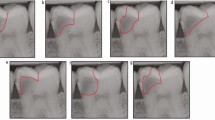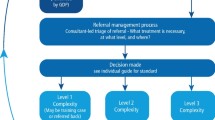Abstract
Aims To investigate current trends in endodontic irrigation amongst general dental practitioners (GDPs) and dental schools within UK and Ireland. Secondly, to evaluate if significant differences exist between the irrigant practices of National Health Service (NHS) and private GDPs.
Methodology In 2019, an online questionnaire was distributed to the 18 dental schools within the UK and Ireland and 8,568 GDPs. These surveys explored current trends in teaching and usage of endodontic irrigants. Chi-squared tests were performed to make comparisons between NHS and private GDPs (α <0.01).
Results All 18 dental schools (100%) and 495 GDPs (6%) returned valid questionnaires. Three hundred and thirty (66.7%) practitioners were NHS and 165 (33.3%) were private. There was strong consensus on irrigation teaching amongst dental schools. These results aligned with GDP responses in terms of irrigant selection (sodium hypochlorite [NaOCl]); NaOCl concentration (≤3%); ethylenediaminetetraacetic acid (EDTA) contact time (>0-5 minutes); final rinse protocols (penultimate EDTA rinse); irrigant temperature (room); and agitation techniques (manual dynamic activation; >0-60 seconds). There was, however, considerable variation in NaOCl contact time and GDPs infrequently used chelating agents or agitation techniques. Compared with private practitioners, NHS GDPs used significantly lower NaOCl contact times and concentrations, less EDTA and activation techniques, and more chlorhexidine (P <0.01).
Conclusions Overall, irrigation teaching within the UK and Ireland is consistent and evidence-based. Furthermore, trends in irrigant usage amongst UK GDPs are now more aligned with these teaching practices. Significant differences were, however, observed between NHS and private practitioners.
This is a preview of subscription content, access via your institution
Access options
Subscribe to this journal
Receive 24 print issues and online access
$259.00 per year
only $10.79 per issue
Buy this article
- Purchase on Springer Link
- Instant access to full article PDF
Prices may be subject to local taxes which are calculated during checkout
Similar content being viewed by others
References
Nair P N. Apical periodontitis: a dynamic encounter between root canal infection and host response. Periodontol 2000, 1997; 13: 121-148.
Siqueira J F, Rôças I D. Clinical implications and microbiology of bacterial persistence after treatment procedures. J Endod 2008; 34: 1291-1301.
Haapasalo M, Shen Y, Wang Z, Gao Y. Irrigation in endodontics. Br Dent J 2014; 216: 299-303.
Peters O A, Schönenberger K, Laib A. Effects of four Ni-Ti preparation techniques on root canal geometry assessed by micro computed tomography. Int Endod J 2001; 34: 221-230.
Siqueira J F, Rôças I D, Marceliano-Alves M F, Pérez A R, Ricucci D.. Unprepared root canal surface areas: causes, clinical implications, and therapeutic strategies. Braz Oral Res 2018; DOI: 10.1590/1807-3107bor-2018.vol32.0065.
Whitworth J M, Seccombe G V, Shoker K, Steele J G. Use of rubber dam and irrigant selection in UK general dental practice. Int Endod J 2000; 33: 435-441.
Jenkins S M, Hayes S J, Dummer P M. A study of endodontic treatment carried out in dental practice within the UK. Int Endod J 2001; 34: 16-22.
Palmer N O, Ahmed M, Grieveson B. An investigation of current endodontic practice and training needs in primary care in the north west of England. Br Dent J 2009; DOI: 10.1038/sj.bdj.2009.47.
Clarkson R M, Podlich H M, Savage N W, Moule A J. A survey of sodium hypochlorite use by general dental practitioners and endodontists in Australia. Aust Dent J 2003; 48: 20-26.
Dutner J, Mines P, Anderson A. Irrigation trends among American association of endodontists members: A web-based survey. J Endod 2012; 38: 37-40.
Kaptan R F, Haznedaroglu F, Kayahan M B, Basturk F B. An investigation of current endodontic practice in Turkey. ScientificWorldJournal 2012; DOI: 10.1100/2012/565413.
Keswani U S, Pawar A M. Root Canal Irrigation Trends When Using Sodium Hypochlorite: A Nationwide Survey Among Indian Dentists. J Dent Med Sci 2017; 16: 38-44.
Zehnder M. Root canal irrigants. J Endod 2006; 32: 389-398.
Haapasalo M, Endal U, Zandi H, Coil J M. Eradication of endodontic infection by instrumentation and irrigation solutions. Endod Topics 2005; 10: 77-102.
Prada I, Micó-Muñoz P, Giner-Lluesma T, Micó-Martínez P, Muwaquet-Rodríguez S, Albero-Monteagudo A. Update of the therapeutic planning of irrigation and intracanal medication in root canal treatment. A literature review. J Clin Exp Dent 2019; DOI: 10.4317/jced.55560.
Oxley C J, Dennick R, Batchelor P. The standard of newly qualified dental graduates - foundation trainer perceptions. Br Dent J 2017; 222: 391-395.
Qualtrough A, Dummer P. Undergraduate endodontic teaching in the United Kingdom: an update. Int Endod J 1997; 30: 234-239.
Al Raisi H, Dummer P, Vianna M. How is Endodontics taught? A survey to evaluate undergraduate endodontic teaching in dental schools within the United Kingdom. Int Endod J 2019; 52: 1077-1085.
Office for National Statistics. Available online at https://www.ons.gov.uk/ (accessed July 2019).
De Moor R, Hülsmann M, Kirkevang L L, Tanalp J, Whitworth J. Undergraduate curriculum guidelines for Endodontology. Int Endod J 2013; 46: 1105-1114.
Ng Y, Gulabivala K, Mann V. A prospective study of the factors affecting outcomes of non-surgical root canal treatment: part 1 periapical health. Int Endod J 2011; 44: 583−609.
Nakonechna A, Dore P, Dixon T et al. Immediate hypersensitivity to chlorhexidine is increasingly recognised in the United Kingdom. Allergol Immunopathol (Madr) 2014; 42: 44-49.
Pemberton M N. Allergy to Chlorhexidine. Dent Update 2016; 43: 272-274.
D'Arcangelo C, Varvara G, De Fazio P. An evaluation of the action of different root canal irrigants on facultative aerobic-anaerobic, obligate anaerobic, and microaerophilic bacteria. J Endod 1999; 25: 351-353.
Okino L A, Siqueira E L, Santos M, Bombana A C, Figueiredo J A. Dissolution of pulp tissue by aqueous solution of chlorhexidine digluconate and chlorhexidine digluconate gel. Int Endod J 2004; 37: 38-41.
Mehdipour O, Kleier D J, Averbach R E. Anatomy of sodium hypochlorite accidents. Compend Contin Educ Dent 2007; 28: 544-550.
Spanó J C, Barbin E L, Santos T C, Guimarães L F, Pécora J D. Solvent action of sodium hypochlorite on bovine pulp and physico-chemical properties of resulting liquid. Braz Dent J 2001; 12: 154-157.
Brocklehurst P, Price J, Glenny A M et al. The effect of different methods of remuneration on the behaviour of primary care dentists. Cochrane Database Syst Rev 2013; DOI: 10.1002/14651858.CD009853.pub2.
Calt S, Serper A. Time-dependent effects of EDTA on dentin structures. J Endod 2002; 28: 17-19.
Niu W, Yoshioka T, Kobayashi C, Suda H. A scanning electron microscopic study of dentinal erosion by final irrigation with EDTA and NaOCl solutions. Int Endod J 2002; 35: 934-939.
Qian W, Shen Y, Haapasalo M. Quantitative analysis of the effect of irrigant solution sequences on dentin erosion. J Endod 2011; 37: 1437-1441.
Zhang K, Tay F R, Kim Y K et al. The effect of initial irrigation with two different sodium hypochlorite concentrations on the erosion of instrumented radicular dentin. Dent Mater 2010; 26: 514-523.
Mai S, Kim Y K, Arola D D et al. Differential aggressiveness of ethylenediaminetetraacetic acid in causing canal wall erosion in the presence of sodium hypochlorite. J Dent 2010; 38: 201-206.
Virdee S S, Seymour D W, Farnell D, Bhamra G, Bhakta S. Efficacy of irrigant activation techniques in removing intracanal smear layer and debris from mature permanent teeth: a systematic review and meta-analysis. Int Endod J 2018; 51: 605-621.
Virdee S S, Farnell D, Silva M A, Camilleri J, Cooper P R, Tomson P L. The influence of irrigant activation, concentration and contact time on sodium hypochlorite penetration into root dentine: an ex vivo experiment. Int Endod J 2020; 53: 986-997.
McDonald R, Cheraghi-Sohi S, Sanders C, Tickle M. Changes to financial incentives in English dentistry 2006-2009: a qualitative study. Community Dent Oral Epidemiol 2012; 40: 468-473.
Tickle M, McDonald R, Franklin J, Aggarwal V R, Milsom K, Reeves D. Paying for the wrong kind of performance? Financial incentives and behaviour changes in National Health Service dentistry 1992-2009. Community Dent Oral Epidemiol 2011; 39: 465-473.
Căpută P E, Retsas A, Kuijk L, Chávez de Paz L E, Boutsioukis C. Ultrasonic Irrigant Activation during Root Canal Treatment: A Systematic Review. J Endod 2019; 45: 31-44.
Silva E J N L, Rover G, Belladonna F G, Herrera D R, De-Deus G, da Silva Fidalgo T K. Effectiveness of passive ultrasonic irrigation on periapical healing and root canal disinfection: a systematic review. Br Dent J 2019; 227: 228-234.
Acknowledgements
The authors are extremely grateful to their colleagues who took time from their busy schedules to complete these questionnaires.
Author information
Authors and Affiliations
Corresponding author
Ethics declarations
The authors explicitly declare no conflicts of interest.
Electronic supplementary material
Rights and permissions
About this article
Cite this article
Virdee, S., Ravaghi, V., Camilleri, J. et al. Current trends in endodontic irrigation amongst general dental practitioners and dental schools within the United Kingdom and Ireland: a cross-sectional survey. Br Dent J (2020). https://doi.org/10.1038/s41415-020-1984-x
Published:
DOI: https://doi.org/10.1038/s41415-020-1984-x
This article is cited by
-
Cleaning efficacy of EDDY versus ultrasonically-activated irrigation in root canals: a systematic review and meta-analysis
BMC Oral Health (2023)
-
Conventional vs ultrasonic irrigation - which leads to less post-operative pain?
Evidence-Based Dentistry (2022)
-
Clinical and microbiological effects of ultrasonically activated irrigation versus syringe irrigation during endodontic treatment: a systematic review and meta-analysis of randomized clinical trials
Odontology (2022)



